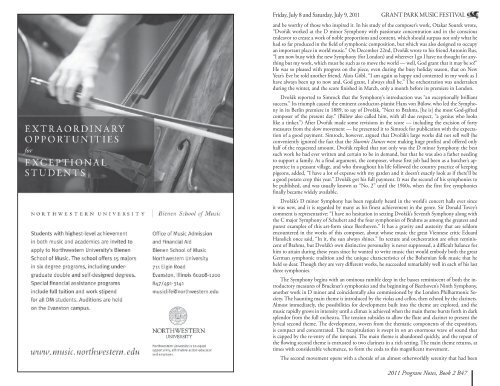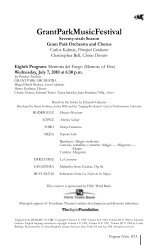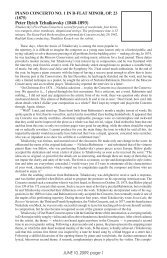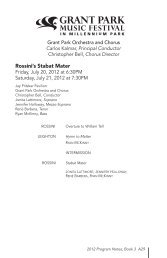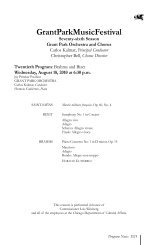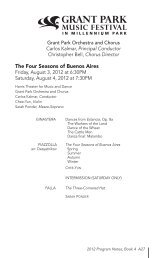2011 Program Book 2 - Spanish Guitar - July 8 & 9.pdf
2011 Program Book 2 - Spanish Guitar - July 8 & 9.pdf
2011 Program Book 2 - Spanish Guitar - July 8 & 9.pdf
Create successful ePaper yourself
Turn your PDF publications into a flip-book with our unique Google optimized e-Paper software.
Friday, <strong>July</strong> 8 and Saturday, <strong>July</strong> 9, <strong>2011</strong><br />
GRANT PARK MUSIC FESTIVAL<br />
and be worthy of those who inspired it. In his study of the composer’s work, Otakar Sourek wrote,<br />
“Dvořák worked at the D minor Symphony with passionate concentration and in the conscious<br />
endeavor to create a work of noble proportions and content, which should surpass not only what he<br />
had so far produced in the field of symphonic composition, but which was also designed to occupy<br />
an important place in world music.” On December 22nd, Dvořák wrote to his friend Antonín Rus,<br />
“I am now busy with the new Symphony (for London) and wherever I go I have no thought for anything<br />
but my work, which must be such as to move the world — well, God grant that it may be so!”<br />
He was so pleased with progress on the piece, even during the busy holiday season, that on New<br />
Year’s Eve he told another friend, Alois Göbl, “I am again as happy and contented in my work as I<br />
have always been up to now and, God grant, I always shall be.” The orchestration was undertaken<br />
during the winter, and the score finished in March, only a month before its premiere in London.<br />
Dvořák reported to Simrock that the Symphony’s introduction was “an exceptionally brilliant<br />
success.” Its triumph caused the eminent conductor-pianist Hans von Bülow, who led the Symphony<br />
in its Berlin premiere in 1889, to say of Dvořák, “Next to Brahms, [he is] the most God-gifted<br />
composer of the present day.” (Bülow also called him, with all due respect, “a genius who looks<br />
like a tinker.”) After Dvořák made some revisions in the score — including the excision of forty<br />
measures from the slow movement — he presented it to Simrock for publication with the expectation<br />
of a good payment. Simrock, however, argued that Dvořák’s large works did not sell well (he<br />
conveniently ignored the fact that the Slavonic Dances were making huge profits) and offered only<br />
half of the requested amount. Dvořák replied that not only was the D minor Symphony the best<br />
such work he had ever written and certain to be in demand, but that he was also a father needing<br />
to support a family. As a final argument, the composer, whose first job had been as a butcher’s apprentice<br />
in a peasant village, and who throughout his life followed the country practice of keeping<br />
pigeons, added, “I have a lot of expense with my garden and it doesn’t exactly look as if there’ll be<br />
a good potato crop this year.” Dvořák got his full payment. It was the second of his symphonies to<br />
be published, and was usually known as “No. 2” until the 1960s, when the first five symphonies<br />
finally became widely available.<br />
Dvořák’s D minor Symphony has been regularly heard in the world’s concert halls ever since<br />
it was new, and it is regarded by many as his finest achievement in the genre. Sir Donald Tovey’s<br />
comment is representative: “I have no hesitation in setting Dvořák’s Seventh Symphony along with<br />
the C major Symphony of Schubert and the four symphonies of Brahms as among the greatest and<br />
purest examples of this art-form since Beethoven.” It has a gravity and austerity that are seldom<br />
encountered in the works of this composer, about whose music the great Viennese critic Eduard<br />
Hanslick once said, “In it, the sun always shines.” Its texture and orchestration are often reminiscent<br />
of Brahms, but Dvořák’s own distinctive personality is never suppressed, a difficult balance for<br />
him to attain during these years since he wanted to write music that would embody both the great<br />
German symphonic tradition and the unique characteristics of the Bohemian folk music that he<br />
held so dear. Though they are very different works, he succeeded remarkably well in each of his last<br />
three symphonies.<br />
The Symphony begins with an ominous rumble deep in the basses reminiscent of both the introductory<br />
measures of Bruckner’s symphonies and the beginning of Beethoven’s Ninth Symphony,<br />
another work in D minor and coincidentally also commissioned by the London Philharmonic Society.<br />
The haunting main theme is introduced by the violas and cellos, then echoed by the clarinets.<br />
Almost immediately, the possibilities for development built into the theme are explored, and the<br />
music rapidly grows in intensity until a climax is achieved when the main theme bursts forth in dark<br />
splendor from the full orchestra. The tension subsides to allow the flute and clarinet to present the<br />
lyrical second theme. The development, woven from the thematic components of the exposition,<br />
is compact and concentrated. The recapitulation is swept in on an enormous wave of sound that<br />
is capped by the re-entry of the timpani. The main theme is abandoned quickly, and the repeat of<br />
the flowing second theme is entrusted to two clarinets in a rich setting. The main theme returns, at<br />
times with considerable vehemence, to form the coda to this magnificent movement.<br />
The second movement opens with a chorale of an almost otherworldly serenity that had been<br />
<strong>2011</strong> <strong>Program</strong> Notes, <strong>Book</strong> 2 B47


